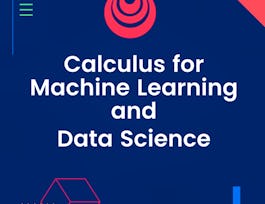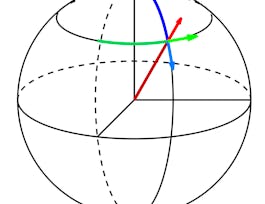This course offers a brief introduction to the multivariate calculus required to build many common machine learning techniques. We start at the very beginning with a refresher on the “rise over run” formulation of a slope, before converting this to the formal definition of the gradient of a function. We then start to build up a set of tools for making calculus easier and faster. Next, we learn how to calculate vectors that point up hill on multidimensional surfaces and even put this into action using an interactive game. We take a look at how we can use calculus to build approximations to functions, as well as helping us to quantify how accurate we should expect those approximations to be. We also spend some time talking about where calculus comes up in the training of neural networks, before finally showing you how it is applied in linear regression models. This course is intended to offer an intuitive understanding of calculus, as well as the language necessary to look concepts up yourselves when you get stuck. Hopefully, without going into too much detail, you’ll still come away with the confidence to dive into some more focused machine learning courses in future.



Mathematics for Machine Learning: Multivariate Calculus
This course is part of Mathematics for Machine Learning Specialization



Instructors: Samuel J. Cooper
Sponsored by Coursera for Reliance Family
144,805 already enrolled
(5,660 reviews)
Skills you'll gain
Details to know

Add to your LinkedIn profile
25 assignments
See how employees at top companies are mastering in-demand skills

Build your subject-matter expertise
- Learn new concepts from industry experts
- Gain a foundational understanding of a subject or tool
- Develop job-relevant skills with hands-on projects
- Earn a shareable career certificate


Earn a career certificate
Add this credential to your LinkedIn profile, resume, or CV
Share it on social media and in your performance review

There are 6 modules in this course
Understanding calculus is central to understanding machine learning! You can think of calculus as simply a set of tools for analysing the relationship between functions and their inputs. Often, in machine learning, we are trying to find the inputs which enable a function to best match the data. We start this module from the basics, by recalling what a function is and where we might encounter one. Following this, we talk about the how, when sketching a function on a graph, the slope describes the rate of change of the output with respect to an input. Using this visual intuition we next derive a robust mathematical definition of a derivative, which we then use to differentiate some interesting functions. Finally, by studying a few examples, we develop four handy time saving rules that enable us to speed up differentiation for many common scenarios.
What's included
10 videos4 readings6 assignments1 discussion prompt1 plugin
Building on the foundations of the previous module, we now generalise our calculus tools to handle multivariable systems. This means we can take a function with multiple inputs and determine the influence of each of them separately. It would not be unusual for a machine learning method to require the analysis of a function with thousands of inputs, so we will also introduce the linear algebra structures necessary for storing the results of our multivariate calculus analysis in an orderly fashion.
What's included
9 videos5 assignments2 ungraded labs
Having seen that multivariate calculus is really no more complicated than the univariate case, we now focus on applications of the chain rule. Neural networks are one of the most popular and successful conceptual structures in machine learning. They are build up from a connected web of neurons and inspired by the structure of biological brains. The behaviour of each neuron is influenced by a set of control parameters, each of which needs to be optimised to best fit the data. The multivariate chain rule can be used to calculate the influence of each parameter of the networks, allow them to be updated during training.
What's included
6 videos3 assignments1 programming assignment1 discussion prompt1 ungraded lab
The Taylor series is a method for re-expressing functions as polynomial series. This approach is the rational behind the use of simple linear approximations to complicated functions. In this module, we will derive the formal expression for the univariate Taylor series and discuss some important consequences of this result relevant to machine learning. Finally, we will discuss the multivariate case and see how the Jacobian and the Hessian come in to play.
What's included
9 videos5 assignments1 plugin
If we want to find the minimum and maximum points of a function then we can use multivariate calculus to do this, say to optimise the parameters (the space) of a function to fit some data. First we’ll do this in one dimension and use the gradient to give us estimates of where the zero points of that function are, and then iterate in the Newton-Raphson method. Then we’ll extend the idea to multiple dimensions by finding the gradient vector, Grad, which is the vector of the Jacobian. This will then let us find our way to the minima and maxima in what is called the gradient descent method. We’ll then take a moment to use Grad to find the minima and maxima along a constraint in the space, which is the Lagrange multipliers method.
What's included
4 videos4 assignments1 discussion prompt1 ungraded lab
In order to optimise the fitting parameters of a fitting function to the best fit for some data, we need a way to define how good our fit is. This goodness of fit is called chi-squared, which we’ll first apply to fitting a straight line - linear regression. Then we’ll look at how to optimise our fitting function using chi-squared in the general case using the gradient descent method. Finally, we’ll look at how to do this easily in Python in just a few lines of code, which will wrap up the course.
What's included
4 videos1 reading2 assignments1 programming assignment1 ungraded lab1 plugin
Instructors



Offered by
Why people choose Coursera for their career




Learner reviews
5,660 reviews
- 5 stars
77.06%
- 4 stars
18.82%
- 3 stars
3.12%
- 2 stars
0.63%
- 1 star
0.35%
Showing 3 of 5660
Reviewed on Jul 24, 2018
I highly recommend this course.
Reviewed on Jan 12, 2021
Quality of instruction and the visual presentation was superb. Completing the second course in this specialisation in Machine Learning has improved my confidence to tackle more advanced topics
Reviewed on Nov 25, 2018
Great course to develop some understanding and intuition about the basic concepts used in optimization. Last 2 weeks were a bit on a lower level of quality then the rest in my opinion but still great.
Recommended if you're interested in Math and Logic

Imperial College London

DeepLearning.AI

DeepLearning.AI

The Hong Kong University of Science and Technology

Open new doors with Coursera Plus
Unlimited access to 10,000+ world-class courses, hands-on projects, and job-ready certificate programs - all included in your subscription
Advance your career with an online degree
Earn a degree from world-class universities - 100% online
Join over 3,400 global companies that choose Coursera for Business
Upskill your employees to excel in the digital economy


